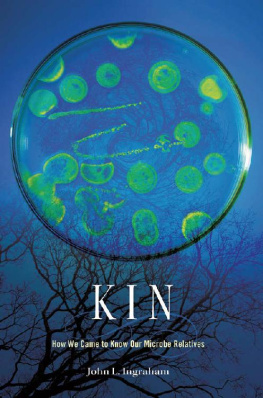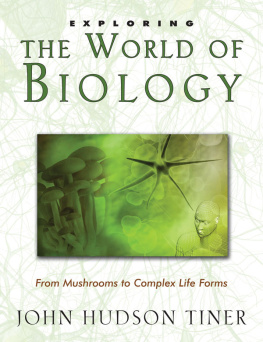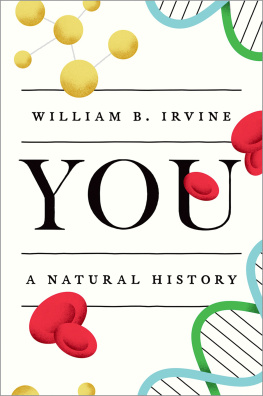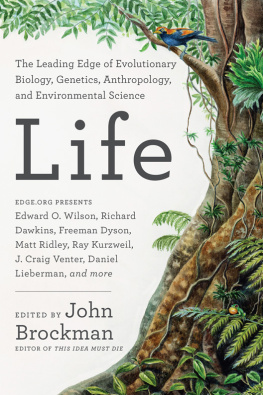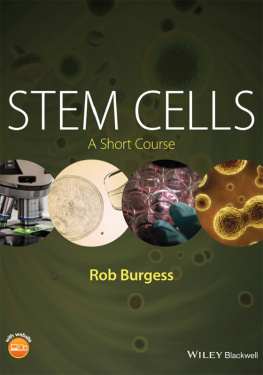KIN
How We Came to Know Our Microbe Relatives
JOHN L. INGRAHAM


CAMBRIDGE, MASSACHUSETTS
LONDON, ENGLAND
2017
Copyright 2017 by the President and Fellows of Harvard College
All rights reserved
Many of the designations used by manufacturers and sellers to distinguish their products are claimed as trademarks. Where those designations appear in this book and Harvard University Press was aware of a trademark claim, then the designations have been printed in initial capital letters.
Design by Dean Bornstein
Jacket art: top: Wladimir Bulgar / Science Photo Library; center: Thomas M. Scheer / EyeEm; bottom: David Crunelle / EyeEm. All Getty Images
Jacket design: Lisa Roberts
978-0-674-66040-3 (alk. paper)
978-0-674-96926-0 (EPUB)
978-0-674-97927-7 (MOBI)
978-0-674-97925-3 (PDF)
The Library of Congress has cataloged the printed edition as follows:
Names: Ingraham, John L., author.
Title: Kin : how we came to know our microbe relatives / John L. Ingraham.
Description: Cambridge, Massachusetts : Harvard University Press, 2017. | Includes bibliographical references and index.
Identifiers: LCCN 2016037619
Subjects: LCSH: MicroorganismsEvolution. | BacteriaEvolution. | Evolution (Biology) | LifeOrigin.
Classification: LCC QR13 .I547 2017 | DDC 579/.138dc23
LC record available at https://lccn.loc.gov/2016037619
For Nancy

Contents
In 1859 Charles Darwin published his paradigm-changing book The Origin of Species by Means of Natural Selection, or the Preservation of Favoured Races in the Struggle for Life and provided a rational explanation for the driving force of evolution. Biologists ever since have set about tracing evolutions multiple, interconnecting pathways with considerable success. By this means they have been able to outline relationships among organisms. Up until the 1970s all such studies were constrained by their reliance on a single kind of evidence: morphology, the shapes and sizes of things. Evolutionary relationships were traced by how organisms looked. Extant species and fossils of organisms that resembled one another were presumed to be related because they shared a common genetic past. Relationships among many plants and animals were quite successfully deciphered this way. Darwin himself participated. He traced the evolutionary history and relatedness of barnacles simply by meticulously studying the similarities and differences in the shapes of the parts of their various species. There are, of course, obvious limitations to such an approach. How do we determine the relationships among organisms that are so different that they lack any common morphological features? How is a pine tree related to a barnacle? In addition, how do we determine relatedness among a group of microorganisms whose morphology is so simple that many of them that we now know to be quite different genetically look almost the same. Or perhaps even more fundamentally, how do we determine the possible relationships of microbes to plants and animals? Distinguished biologists despaired that such questions could ever be answered. Then in the 1970s a scientific bombshell shook the field of biology. Biologists realized that the history of relatedness of all living things is recorded in the molecular morphology of the constituents of cells. This insight has led to discoveries that have changed biology profoundly, allowing us to glimpse the entire universal Tree of Life and see for the first time our position in the complex web of nature, a revelation both humbling and revolutionary.
Come in; come in. The gods are here too.
Aristotle, On the Parts of Animals
Were fascinated by our origins. The worlds vastly disparate religions share a common fascination with our and all lifes beginnings. Both DNA testing and internet databases are available to search for ones relations, ancestors, and ethnic origins. We and our ancestors have often seemed driven to know where we came from as individuals and as a species. Relatively recently, some of these most primal questions have been definitively answered: we have come to discover our collective origins, at least in broad outline, and to recognize our remarkable kinship to microbes.
Modern biology has constructed a new scientific origin tale with an impact equivalent to cosmologys big bang theory. The components are the newly established relationships among living things. Assembled, they make a clear and dramatic statement: we are all kin. From the smallest bacterium to the largest blue whale, we are all fellow members of the same inclusive family of life. We are connected by common and traceable inheritance that leads back to this familys microbial beginnings.
Since Charles Darwin, biologists have suspected that we descended through a single, branching pathway of life, but now its been unequivocally established. As we might anticipate, parts of the pathway have some unusual twists and turns. This common legacy of living things, which has been established with certainty only during the past forty-odd years, has gone largely unnoticed, or at least underappreciated, by those of us who arent biologists. We still dont know where were going and can only guess about how it all began, but now we do know with certainty where we and our fellow living creatures came from; to whom we are related and how closely.
This research establishes much more than lifes singularity. It displays the relative closeness of the relationships among various organisms as well as their genetic interconnections. It tells how we acquired individual components of our cells: how our proteins evolved by assembling component parts from disparate sources, and how some of our essential cellular functions were acquired directly from microbes.
The new origin tale reminds us, as wed already learned from traditional studies and from observing nature, that were most closely related to other animals. As W. Ford Doolittle noted, before this achievement, we would still find it easy to tell birds from bees, or distinguish any bird or bee from broccoli, brewers yeast, or bacteria. But we would have no strong basis for deciding as we have that all birds and bees are closer kin to yeast than to broccoli. Now we know that our relationship extends to all of them. We share common ancestors with plants. Most surprisingly, perhaps, new discoveries not only firmly establish that we are descendants of microbes, they explain our connections to them. The most basic, life-sustaining activities of the cells comprising our bodies, including those that enable us to digest our food and derive metabolic energy from it, evolved in microbes. More fundamentally, we store our life instructions and pass them on to our progeny along the route pioneered by microbes. We werent the venues for developing these fundamental bases of our being; we acquired them through inheritance from our distant microbial relatives.
Perhaps an even greater impact of these studies is the revelation that such things are knowable, that a question of such profundity may be answered by ordinary laboratory experiments, some seemingly mundane and tedious. Might other biological conundrums be similarly penetrable? Certainly the discovery of a totally new class of organism, the archaea, in 1977 came as a major surprise. These newcomers (to us) are unique among living things, as different genetically, biochemically, and evolutionarily from other microbes as they are from us. The novelty of their discovery is unparalleled in the history of modern biologyequivalent only to Anton van Leeuwenhoeks amazement upon discovering a world of microorganisms on the glass beneath his homemade, handheld microscope in the seventeenth century.

